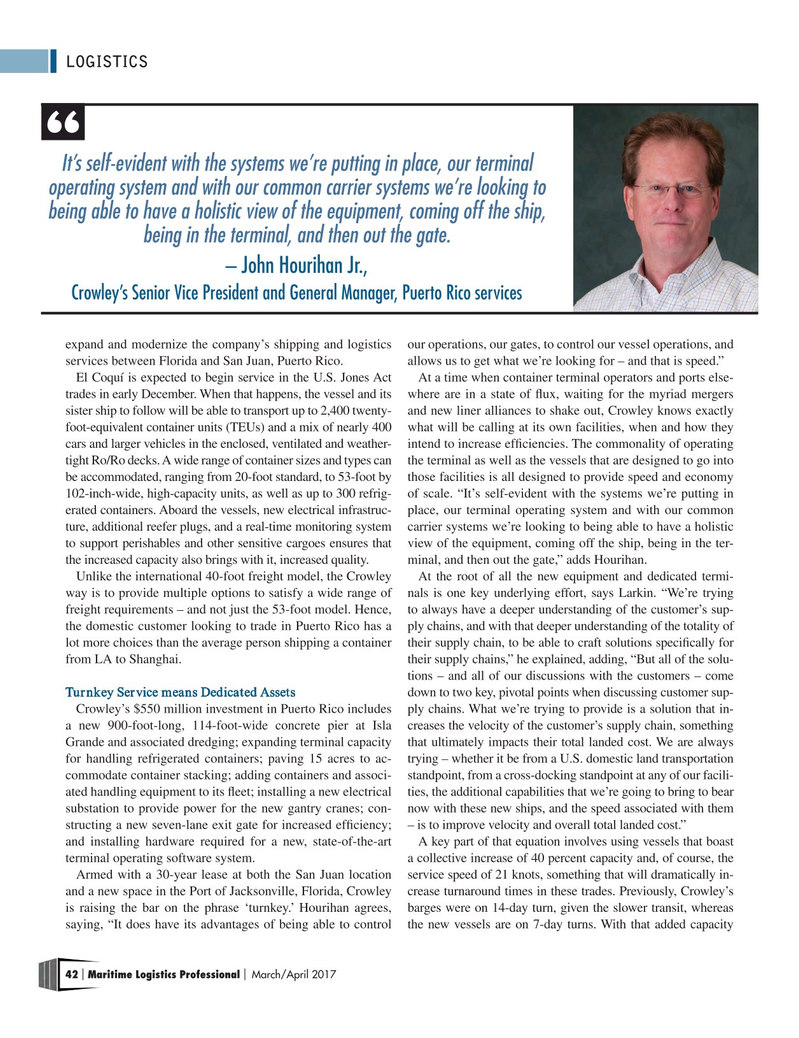
Page 42: of Maritime Logistics Professional Magazine (May/Jun 2017)
BUNKER OPERATIONS & PORTS
Read this page in Pdf, Flash or Html5 edition of May/Jun 2017 Maritime Logistics Professional Magazine
LOGISTICS
It’s self-evident with the systems we’re putting in place, our terminal operating system and with our common carrier systems we’re looking to being able to have a holistic view of the equipment, coming off the ship, being in the terminal, and then out the gate.
– John Hourihan Jr.,
Crowley’s Senior Vice President and General Manager, Puerto Rico services expand and modernize the company’s shipping and logistics our operations, our gates, to control our vessel operations, and services between Florida and San Juan, Puerto Rico. allows us to get what we’re looking for – and that is speed.”
El Coquí is expected to begin service in the U.S. Jones Act At a time when container terminal operators and ports else- trades in early December. When that happens, the vessel and its where are in a state of fux, waiting for the myriad mergers sister ship to follow will be able to transport up to 2,400 twenty- and new liner alliances to shake out, Crowley knows exactly foot-equivalent container units (TEUs) and a mix of nearly 400 what will be calling at its own facilities, when and how they cars and larger vehicles in the enclosed, ventilated and weather- intend to increase effciencies. The commonality of operating tight Ro/Ro decks. A wide range of container sizes and types can the terminal as well as the vessels that are designed to go into be accommodated, ranging from 20-foot standard, to 53-foot by those facilities is all designed to provide speed and economy 102-inch-wide, high-capacity units, as well as up to 300 refrig- of scale. “It’s self-evident with the systems we’re putting in erated containers. Aboard the vessels, new electrical infrastruc- place, our terminal operating system and with our common ture, additional reefer plugs, and a real-time monitoring system carrier systems we’re looking to being able to have a holistic to support perishables and other sensitive cargoes ensures that view of the equipment, coming off the ship, being in the ter- the increased capacity also brings with it, increased quality. minal, and then out the gate,” adds Hourihan.
Unlike the international 40-foot freight model, the Crowley At the root of all the new equipment and dedicated termi- way is to provide multiple options to satisfy a wide range of nals is one key underlying effort, says Larkin. “We’re trying freight requirements – and not just the 53-foot model. Hence, to always have a deeper understanding of the customer’s sup- the domestic customer looking to trade in Puerto Rico has a ply chains, and with that deeper understanding of the totality of lot more choices than the average person shipping a container their supply chain, to be able to craft solutions specifcally for from LA to Shanghai. their supply chains,” he explained, adding, “But all of the solu- tions – and all of our discussions with the customers – come
Turnkey Service means Dedicated Assets down to two key, pivotal points when discussing customer sup-
Crowley’s $550 million investment in Puerto Rico includes ply chains. What we’re trying to provide is a solution that in- a new 900-foot-long, 114-foot-wide concrete pier at Isla creases the velocity of the customer’s supply chain, something
Grande and associated dredging; expanding terminal capacity that ultimately impacts their total landed cost. We are always for handling refrigerated containers; paving 15 acres to ac- trying – whether it be from a U.S. domestic land transportation commodate container stacking; adding containers and associ- standpoint, from a cross-docking standpoint at any of our facili- ated handling equipment to its feet; installing a new electrical ties, the additional capabilities that we’re going to bring to bear substation to provide power for the new gantry cranes; con- now with these new ships, and the speed associated with them structing a new seven-lane exit gate for increased effciency; – is to improve velocity and overall total landed cost.” and installing hardware required for a new, state-of-the-art A key part of that equation involves using vessels that boast terminal operating software system. a collective increase of 40 percent capacity and, of course, the
Armed with a 30-year lease at both the San Juan location service speed of 21 knots, something that will dramatically in- and a new space in the Port of Jacksonville, Florida, Crowley crease turnaround times in these trades. Previously, Crowley’s is raising the bar on the phrase ‘turnkey.’ Hourihan agrees, barges were on 14-day turn, given the slower transit, whereas saying, “It does have its advantages of being able to control the new vessels are on 7-day turns. With that added capacity 42 Maritime Logistics Professional March/April 2017 | |

 41
41

 43
43
